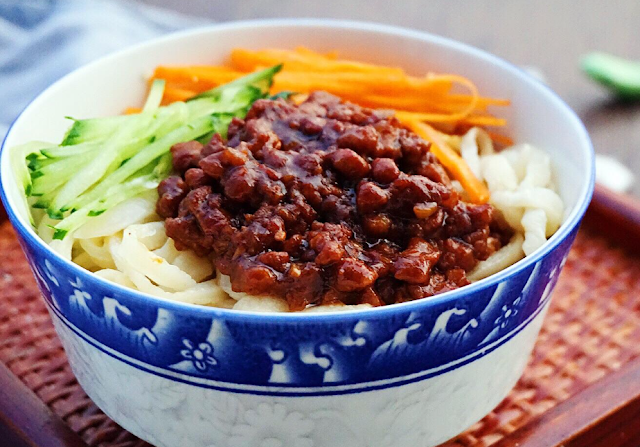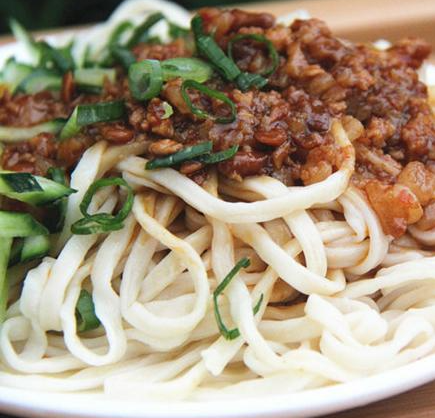The essence of Zha Jiang Mian, the chef teaches you how to make qualified Zha Jiang, don't make mistakes again
- Get link
- X
- Other Apps
About Zha Jiang Mian
Zha Jiang Mian is a traditional Beijing-style noodle dish and is considered one of the "Top Ten Noodles in China". It is made by mixing the "vegetable code" and "fried sauce" with noodles.
About Zha Jiang
Whether it's yellow sauce or sweet bean sauce, they are all fermented products, with a special smell that needs to be dry-fried over low heat to remove. Making Zha Jiang requires "dry-frying in a small bowl". If you make too much at once, the sauce will not be fried thoroughly and won't be crispy. Dry-fry over low heat, and do not add water in the middle. Along with the evaporation of the moisture inside the sauce, it is a process of blending the sauce with diced meat.
To make Zha Jiang, choose fatty pork belly and separate the fat from the lean. Cut it into diced, not minced, pieces. The diced meat should not be too small, or it will become too dry when fried and won't taste good. It is also important to add aromatic spices such as scallions and ginger to enhance the flavor. The sauce is usually made by mixing yellow sauce and sweet bean sauce, with the ratio depending on personal preference. Yellow sauce adds freshness, while sweet bean sauce adds flavor. Some people like only yellow sauce, while others prefer only sweet bean sauce.
As time passes, the heat should be just right. The fatty pork comes with its own oil and will be delicate and moist, while the lean pork will be aromatic. A qualified Zha Jiang should be fried over low heat until the oil and sauce separate. By using chopsticks to separate the sauce, the oil will not stick, resulting in a true and perfect combination of sauce and meat. The sauce should be rich in meaty fragrance, and the meat should be coated with a rich and full sauce.
Regarding making noodles
The noodles used for Zha Jiang Mian appeal to people of all backgrounds, as they can be rough or delicate, common or elegant. Hand-pulled noodles are the most traditional and authentic, but they require a certain level of skill, which takes at least three to five years to master. In contrast, hand-rolled noodles were more recently accepted by people and are relatively simple and easy to handle.
Another type of noodle-making technique is known as "Jiu Pian Er," where the noodles produced are uneven in thickness, adding a unique texture to the overall dish. Regardless of the method, the cooked noodles should be translucent, smooth, and pliable, with good elasticity. Nowadays, people tend to use machine-made noodles at home or purchase fresh noodles that are ready-to-cook.
Regarding the vegetable toppings for Zha Jiang Mian
The vegetable toppings, also known as "Cai Ma," for Zha Jiang Mian can be as simple as a cucumber or a clove of garlic, or as complex as seven or eight different types of vegetables prepared in various ways. The most common vegetables used include cucumbers, carrots, and bean sprouts, while water radish, scallions, celery, cabbage, soybeans, and Chinese toon leaves are also popular options.
The key principle is to choose the freshest and most delicious vegetables available. Vegetable toppings can be classified as "Ming Ma" - the visible toppings, and "An Ma" - the hidden toppings that require blanching. "An Ma" is boiled and mixed with the noodles and sauce, while "Ming Ma" is served on top of the noodles and sauce to preserve its freshness and crunchiness.
Finally, a few cloves of garlic are added to enhance the flavor of the dish, which complements the richness of the sauce. Garlic is the perfect finishing touch to Zha Jiang Mian.
Now let's make zha jiang mian
Ingredients:
Noodles: 500g flour, 200g water, 3g salt, 1.5g food-grade alkaline, 1 egg white (adjust the amount according to the number of people)
Sauce: 50g vegetable oil, 500g pork belly, 200g fermented soybean paste, 100g scallion and ginger water, 100g cooking wine, 100g sweet bean paste, 2-star anise, 50-75g sugar, a small amount of ground pepper, 2g MSG or chicken powder (optional), 100g scallions, and 50g ginger.
Vegetable toppings: Cucumber, celery, garlic, carrots, bean sprouts, etc. (choose according to personal preference)
Steps:
1. Mix 200g of water, 3g salt, 1.5g food-grade alkaline, and 1 egg white, then pour into a mixing bowl. Add 500g of flour and stir until it resembles cotton. Use a noodle maker with a manual rolling function, or roll the dough by hand. If rolling by hand, knead the dough into a smooth and consistent texture, then let it rest for 30 minutes.
Sprinkle a suitable amount of dry flour on the board to prevent sticking. Flatten the dough and use a rolling pin to create a thick pancake-like shape. After spreading it out, sprinkle dry flour on it to prevent sticking, then roll it up and repeat several times to make a pancake with a suitable thickness.
Stack the pancakes on top of each other and cut them into suitable thickness of noodles. Sprinkle dry flour on it to prevent sticking.
2. Choose high-quality pork belly and separate the fatty and lean parts. Cut them into 0.5 cm square cubes. If they are too thin, they may become too dry when fried, affecting the taste.
3. Finely chop the scallions and ginger into small pieces.
4. Add 200g of dried yellow soybean paste, 100g of minced scallion and ginger water, and 100g of cooking wine in a 1:1 ratio of sauce to water. Bring it to a boil. Prepare 100g of sweet bean sauce. If fresh yellow soybean paste is used, the process will be relatively easier.
5. The essence of Zha Jiang Mian lies entirely in the sauce, and the chef will teach you how to make qualified Zha Jiang. Don't make mistakes again. Pour 50 grams of vegetable oil into the pot, heat the pot with the cool oil, add diced fatty pork first, stir-fry over low heat until fragrant and crispy. Then add the diced lean pork, stir-fry until fragrant and cooked through. Add two star anise, stir-fry until fragrant, then add finely chopped ginger and scallions, stir-fry until fragrant, and the aroma is rich.
6. Add in the well-stirred yellow sauce and sweet bean sauce, and fry over low heat. Utilizing the volatilization of cooking wine in the yellow sauce, it removes the bean odor from the yellow sauce, and the entire process of slow frying over low heat is necessary to fry it fragrant and thoroughly, which takes about 30–40 minutes. Keep stirring to prevent sticking to the bottom of the pot. As the water vapor in the sauce evaporates, oil and sauce will eventually separate. Use chopsticks to break open the sauce in the middle, and the oil and sauce will not stick together, achieving a true mix of meat and sauce. The fried sauce is then done. Add 50–75 grams of sugar, a small amount of pepper, and 2 grams of monosodium glutamate or chicken powder (optional) for seasoning. One cannot finish the fried sauce in one meal. After putting the sauce in a bowl and covering it with plastic wrap, it can be eaten for up to three days after being refrigerated. When eating, re-fry it in a pan.
7. Prepare the diced vegetables.












Comments
Post a Comment